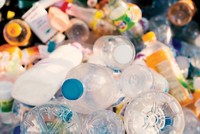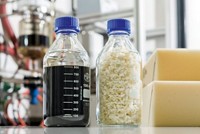Advertisement
Grab your lab coat. Let's get started
Welcome!
Welcome!
Create an account below to get 6 C&EN articles per month, receive newsletters and more - all free.
It seems this is your first time logging in online. Please enter the following information to continue.
As an ACS member you automatically get access to this site. All we need is few more details to create your reading experience.
Not you? Sign in with a different account.
Not you? Sign in with a different account.
ERROR 1
ERROR 1
ERROR 2
ERROR 2
ERROR 2
ERROR 2
ERROR 2
Password and Confirm password must match.
If you have an ACS member number, please enter it here so we can link this account to your membership. (optional)
ERROR 2
ACS values your privacy. By submitting your information, you are gaining access to C&EN and subscribing to our weekly newsletter. We use the information you provide to make your reading experience better, and we will never sell your data to third party members.
Materials
Taking It Back
Material makers will have to adapt to help consumer goods firms fulfill product stewardship goals
by Melody M. Bomgardner
August 1, 2011
| A version of this story appeared in
Volume 89, Issue 31

“Begin with the end in mind.” It’s one of the seven habits of highly effective people, according to leadership guru Steven R. Covey. Highly effective consumer products companies are leaders at prototyping, consumer research, and creating inviting retail environments because, for them, a happy customer is the ideal end state. But companies are starting to recognize that their products have a life after the customer, and that life often isn’t pretty.
A cell phone, a car tire, or a plastic bottle will, more often than not, be thrown away after use. But “away” is not a mythical nonplace; it usually means either a landfill or trash incinerator. All three objects are made with materials that can be recycled, and increasingly they are being recycled. In the U.S., 34% of municipal solid waste was recycled in 2009, versus 10% in 1980, according to the Environmental Protection Agency. For the most part, however, the products consumers use every day were not designed with any end-of-life destination in mind.
The marketplace is showing signs that this shortsightedness will change: Sustainability initiatives of both retailers and consumer products manufacturers increasingly include goals for product stewardship whereby companies plan, and oftentimes pay for, the recycling or appropriate disposal of a product after its useful life. Chemical and material suppliers are being warned by their customers to prepare for the day when these initiatives encompass their products, as well.
Companies committed to taking back merchandise for recycling arrange for their products to flow through a supply chain that they refer to as the “back end.” It’s similar to the forward supply chain that creates products for consumers, only it runs in reverse. And just like in the forward supply chain, which links raw material maker, product manufacturer, and retailer, each of the partners in the reverse supply chain must make a profit for the system to function.
It turns out that reclaiming and reselling valuable materials or managing hazardous ones makes money for a host of resellers and recyclers. Still, planning what to do with used goods would be much easier if material makers got in on the front end of the game, says Allison Gregg, manager of product sustainability for wireless carrier Sprint. To that end, the company is working with cell phone manufacturers such as Samsung to design products for disassembly.
“We recognize that our suppliers are the handset manufacturers,” Gregg says. The company also recognizes that the final end-of-life treatment of any device component depends on what it is made of. Thus, she points out, “you have to go down deep into their supply chain to really understand the roots of the materials that go into the phone.” That digging will reach chemical and material suppliers someday soon, she suggests.
On July 20, the Obama Administration put a spotlight on electronics recycling when it introduced the National Strategy for Electronics Stewardship, a voluntary EPA-industry partnership (C&EN, July 25, page 28).

“A robust electronics recycling industry in America would create new opportunities to efficiently and profitably address a growing pollution threat,” said EPA Administrator Lisa P. Jackson, at the launch of the program. “The participation of industry leaders like Dell, Sprint, and Sony is absolutely essential to this effort, and will help ensure that the work of the federal government—the largest electronics consumer around—is protecting our people from pollution” while supporting savings and job creation through electronics recycling, or e-cycling, and reuse of valuable materials.
The strategy would also “ensure that all electronics used by the federal government are reused or recycled properly,” according to EPA.
Regulations at the state level are already driving retail product companies to formulate stewardship policies. Currently, 25 states have regulations requiring e-cycling, and most make manufacturers responsible for taking back products. An additional four states have introduced legislation this year. EPA data show that, nationally, 19% of consumer electronics were recycled in 2009. Cell phones are normally not included in state laws, and only 10% of handsets were recycled in 2009. But the trend is for state laws to expand the scope of products they cover.

The first state e-cycling laws were put in place in 2006, and the laws are continually being refined, according to Barbara Kyle, national coordinator of the watchdog group Electronics TakeBack Coalition. “Now that there is a little data from programs that have been running a few years, we can see which systems work better,” Kyle says. “When many states first passed the laws, legislators were guessing at how this would work. In my mind, it’s proving to be a pretty valuable policy testing ground for something fairly complex.”
It can take time, but state regulations have been effective in prodding consumer product recycling. In the 1980s, for example, many states began requiring the recycling of lead-acid car batteries. By 1990, according to EPA, 95% of batteries were being recycled, and they are still the most frequently recycled product in the U.S. Probably the best-known example of state policies is bottle-deposit laws. In place in 11 states, they have been shown to boost beverage-container recycling rates to as high as 80%.
Interestingly, most of these laws were not enacted to keep materials out of landfills, although that is often a significant benefit. Battery-recycling laws and similar ones for electronics handling were designed to manage the flow of hazardous materials, primarily lead and mercury, but also cadmium, beryllium, hexavalent chromium, and antimony. And the bottle-deposit laws originated as a way to reduce litter.
In addition to needing to comply with state law, companies are feeling heat from consumers to improve the end-of-life profile of their products. This has been the case recently with packaging, says Elizabeth Shoch, project manager at GreenBlue, which runs the Sustainable Packaging Coalition. “A lot of it is driven by consumers who want to do something good with their packaging and ask, ‘Why can’t I recycle this thing that you sold me?’ Packaging is so visible to the public,” she says. “It gets a bad rap a lot of times.”
Companies that promote their product stewardship to customers can add some environmentally friendly gloss to their brand. For example, in 2010, Sprint, the third-largest wireless provider in the U.S., took back 3.9 million cell phones. “We’re looking for ways to set ourselves apart from the competition, so we are building on our leadership in this space,” remarks Darren Beck, head of corporate responsibility at Sprint. “Many governments and nonprofits, and some consumers, do take into consideration corporate responsibility in their purchasing decision.”
Watchdog groups such as the Electronics TakeBack Coalition continually pressure firms like Sprint to be transparent about their recycling partners and what happens to the electronics they recover. Firms on the back end may be tempted to export electronic waste, or e-waste, to developing countries where environmental and health standards for recycling workers are low or nonexistent. To avoid that potential black eye, brand owners increasingly require their partners to be certified as meeting EPA’s Responsible Recycling Practices (R2) program or the independent e-Stewards standards.

The reverse supply chain has different profit centers for different partners. For example, ReCellular is a private company that refurbishes and resells used mobile devices, many of which come from take-back programs. According to Joe McKeown, vice president for marketing and communications, the company takes in 19 million phones a year, and roughly 70% have resale value. Even nonworking ones have valuable parts, McKeown says. “The last place these devices belong is a landfill.”
After the resellers come the recyclers. They recover and sell plastics, glass, rare-earth elements, valuable metals such as silver and gold, and heavy metals including mercury.
Even if the amounts of material collected from each item are often quite small, the payoff can be significant.
“The circuits on those boards—we recover all those metals. The higher the price of those commodities, the more advantageous it is for companies to collect and for us to process and reclaim those materials,” says Ted Lawson, chemical industry market leader at Veolia Environmental Services, an R2-certified firm that handles all kinds of wastes, including e-waste, and helps its customers fulfill their no-landfill policies. “Depending on the changing economics, our customers may benefit financially or they may be paying a fee.”
To smooth the way for safe handling and recycling of electronics, manufacturers are reducing the amount of lead and mercury in their devices. Some are also trying to avoid polyvinyl chloride or polymers that contain brominated flame retardants.
To make plastics flame retardant, materials makers add halogenated compounds, including brominated flame retardants. In addition, PVC is often used in flexible coatings for cables and wires. The chlorine in the PVC coatings acts as a flame retardant. These materials can release hazardous air pollutants when melted or burned during processing to recover the metals in electronics. Still, safe product design requires materials that will not ignite or spread flames.

Chemical maker DSM offers a suite of alternative, halogen-free engineering plastics aimed at the electronics market and others where recycling is common. “Engineering plastics end up in critical technical applications, whether in automotive, electronics, or food packaging,” says Fredric Petit, director of sustainability at DSM Engineering Plastics.
The company has been working to certify its products as recyclable through the Cradle to Cradle designation developed by McDonough Braungart Design Chemistry, a product design consultancy. The effort “is a newer expansion of our sustainability concept,” Petit says. “We take end of life into account. Then you start to think, ‘Should there be an end of life, or can it be reused and recycled in a closed loop?’ ”
By closed loop, Petit refers to continual reuse and recycling of a material in the same product type, an attribute of raw materials that many customers of chemical and material suppliers increasingly desire. DSM’s Cradle to Cradle products include polyamide, copolyester, and polybutylene terephthalate resins marketed under names such as Akulon, Arnitel, and EcoPaXX.
Unlike steel and glass , which can be recycled endlessly, polymers are usually limited in the amounts that can be reused in the original application and in the number of times they can be recycled without degrading quality. To get the most value, recyclers often must find markets other than the original ones.
Lehigh Technologies, based in Georgia, is a start-up company that has found a niche in recycling rubber from discarded tires and from the waste material of tire makers. Lehigh takes in rubber chunks from firms that recover used tires. It then uses a proprietary milling process to create what it calls micronized rubber powder, with grain sizes as small as 50 μm in diameter. The different powders are sold in various markets including tire making, coatings, sealants, and plastics. Yokohama Rubber, one of Lehigh’s clients, also buys back the powder for use in new tires.
“It’s a great system for our closed-loop customers because they get back exactly the composition they started with, at a particle size to optimize the amount of material they can put in. They save landfill costs and the cost of virgin material, and they can achieve zero waste,” says Lehigh Chief Executive Officer Alan Barton, who earlier in his career led sustainability efforts at Rohm and Haas.
New tires can include 3 to 7% of the micronized rubber powder by weight. “The next phase of the technology road map is to functionalize the rubber powders with chemistry to move to higher loadings that still deliver top-flight performance,” Barton explains. In the meantime, demand from nontire markets has helped the firm expand revenues 40% per year.
Including recycled material in a product does not guarantee that the product itself can be recycled, GreenBlue’s Shoch points out. And packaging makers who use recyclable materials such as plastics or even glass, steel, or aluminum need to ensure they are designing products that can be recycled easily.
“The main problems can come with a package made of a bunch of different materials that can’t be disassembled,” Shoch says. For example, a can made of steel with an aluminum top will be picked up by magnets and sorted with steel, but the aluminum part won’t be recycled, Shoch explains. A similar situation faces polymer-metal-paper aseptic cartons, and makers of these cartons have had to design their own take-back and recycling programs. To help avoid these complications, GreenBlue and the Association of Postconsumer Plastic Recyclers recently put out detailed packaging design guidelines.
Advertisement
For industrial products, the materials may be different but the take-back principle is the same, as Dow Chemical’s experience with chlorinated solvents shows. Use of the solvents, which can pose environmental and health risks if handled improperly, has been phased out in some industries in favor of aqueous cleaners. But chlorinated solvents are still used as degreasers in precision metal manufacturing. Dow’s return program, called Safechem, ensures proper recycling by delivering the chlorinated solvents in sealed containers that connect to washing stations. A waste handler then collects the used solvent in a second sealed container.
“We are a strong proponent of maintaining the use of chlorinated solvents, but we recognize they have to be handled in closed systems,” explains Ann E. Davis, environmental, health, and safety global product leader for Dow’s basic chemicals business. The recovered solvents can be distilled by the waste handler and either reused by customers or serve as raw materials within Dow. Davis says the program meets the tenets of Responsible Care and Dow’s product stewardship goals.

As take-back programs proliferate, many industry observers are waiting to see whether lessons learned by the players on the back end of the supply chain—the resellers and recyclers—will influence manufacturers and material makers at the front of the chain. Although rarely asked, recyclers like Veolia can provide useful insights, Lawson says: “We can look at the current technologies and economic constraints. We can examine the product as a whole and its components and look for a more sustainable state.”
The conversations are just beginning to move in the direction of manufacturers and their raw material suppliers, Sprint’s Beck says. “We have been working with the Underwriters Laboratories Environment program over the last year to establish a standard for sustainable mobile devices—basically green cell phones—and we’ve had to gather input from all phases up and down the supply chain, including a number of manufacturers as well as our recyclers.”
Shoch of GreenBlue adds, “We’re hoping that packaging designers can ask questions, such as to an adhesive supplier: ‘Do you know how this performs in recycling?’ A supplier should be able to answer that question.”
It would be better if material makers didn’t wait to be asked, says Kyle of the Electronics TakeBack Coalition. “We feel that very little is being done to really foster the development of safer alternatives. Manufacturers may want to find these things, but they are not the ones who have chemists working for them,” she points out. “In fact, many manufacturers don’t know the chemicals in their products. We need some type of initiative within industry that includes the chemical companies, manufacturers, and component makers. What would it take to actually make that happen?”






Join the conversation
Contact the reporter
Submit a Letter to the Editor for publication
Engage with us on Twitter